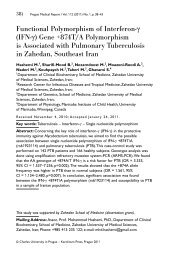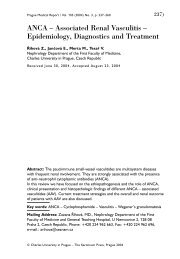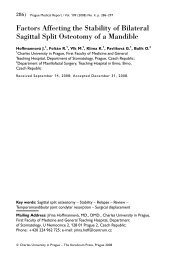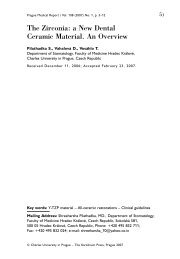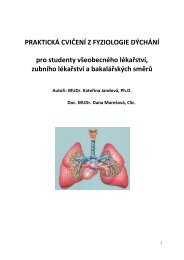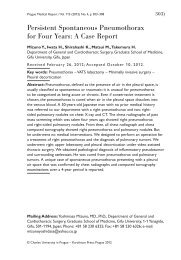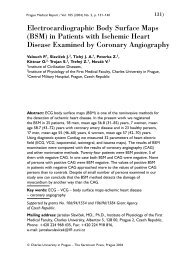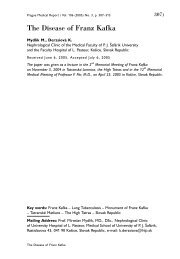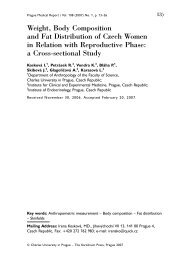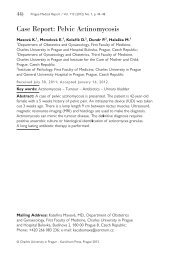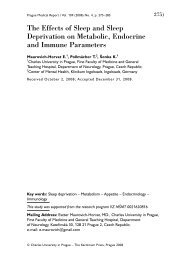(PDF). - Prague Medical Report
(PDF). - Prague Medical Report
(PDF). - Prague Medical Report
Create successful ePaper yourself
Turn your PDF publications into a flip-book with our unique Google optimized e-Paper software.
136) <strong>Prague</strong> <strong>Medical</strong> <strong>Report</strong> / Vol. 113 (2012) No. 2, p. 136–146<br />
Novel Mutations in the Tyrosine Hydroxylase<br />
Gene in the First Czech Patient with Tyrosine<br />
Hydroxylase Deficiency<br />
Szentiványi K. 1 , Hansíková H. 1 , Krijt J. 2 , Vinšová K. 1 , Tesařová M. 1 ,<br />
Rozsypalová E. 1 , Klement P. 1 , Zeman J. 1 , Honzík T. 1<br />
1 Department of Pediatrics and Adolescent Medicine, First Faculty of Medicine,<br />
Charles University in <strong>Prague</strong> and General University Hospital in <strong>Prague</strong>, <strong>Prague</strong>,<br />
Czech Republic;<br />
2 Institute of Inherited Metabolic Disorders, First Faculty of Medicine, Charles<br />
University in <strong>Prague</strong> and General University Hospital in <strong>Prague</strong>, <strong>Prague</strong>, Czech<br />
Republic<br />
Received September 9, 2011; Accepted April 11, 2012.<br />
Key words: Cerebrospinal fluid – Liquid chromatography – Neurotransmitter<br />
disorder – Tyrosine hydroxylase<br />
Abstract: Tyrosine hydroxylase deficiency manifests mainly in early childhood<br />
and includes two clinical phenotypes: an infantile progressive hypokinetic-rigid<br />
syndrome with dystonia (type A) and a neonatal complex encephalopathy (type B).<br />
The biochemical diagnostics is exclusively based on the quantitative determination<br />
of the neurotransmitters or their metabolites in cerebrospinal fluid (CSF). The<br />
implementation of neurotransmitter analysis in clinical praxis is necessary for early<br />
diagnosis and adequate treatment. Neurotransmitter metabolites in CSF were<br />
analyzed in 82 children (at the age 1 month to 17 years) with clinical suspicion for<br />
neurometabolic disorders using high performance liquid chromatography (HPLC)<br />
with electrochemical detection. The CSF level of homovanillic acid (HVA) was<br />
markedly decreased in three children (64, 79 and 94 nmol/l) in comparison to<br />
This study was supported by the grant from the Ministry of Health of the Czech Republic<br />
IGA NS 10561-3/2009.<br />
Mailing Address: Assoc. Prof. Tomáš Honzík, MD., PhD., Department<br />
of Pediatrics and Adolescent Medicine, First Faculty of Medicine, Charles University<br />
in <strong>Prague</strong> and General University Hospital in <strong>Prague</strong>, Ke Karlovu 2, 128 08 <strong>Prague</strong> 2,<br />
Czech Republic; Phone: +420 224 967 792; Fax: +420 224 967 113; e-mail:<br />
tomas.honzik@vfn.cz<br />
© Charles University in <strong>Prague</strong> – Karolinum Press, <strong>Prague</strong> 2012
<strong>Prague</strong> <strong>Medical</strong> <strong>Report</strong> / Vol. 113 (2012) No. 2, p. 136–146<br />
137)<br />
age related controls (lower limit 218–450 nmol/l). Neurological findings including<br />
severe psychomotor retardation, quadruspasticity and microcephaly accompanied<br />
with marked dystonia, excessive sweating in the first patient was compatible with<br />
the diagnosis of tyrosine hydroxylase (TH) deficiency (type B) and subsequent<br />
molecular analysis revealed two novel heterozygous mutations c.636A>C and<br />
c.1124G>C in the TH gene. The treatment with L-DOPA/carbidopa resulted in the<br />
improvement of dystonia. Magnetic resonance imaging studies in two other patients<br />
with microcephaly revealed postischaemic brain damage, therefore secondary<br />
HVA deficit was considered in these children. Diagnostic work-up in patients with<br />
neurometabolic disorders should include analysis of neurotransmitter metabolites in<br />
CSF.<br />
Introduction<br />
Paediatric neurotransmitter disorders refer to an inherited group of neurometabolic<br />
syndromes attributable to a disturbance of neurotransmitter metabolism. Ten<br />
enzyme deficiencies in the pathway of the biogenic amines metabolism have been<br />
described, until now (Pearl et al., 2007). The enzyme tyrosine hydroxylase (TH;<br />
EC 1.14.162) catalyzes the conversion of L-tyrosine to L-dihydroxyphenylalanine<br />
(L-dopa), which is the rate-limiting step in the biosynthesis of the catecholamines<br />
dopamine, norepinephrine and epinephrine.<br />
Human tyrosine hydroxylase deficiency (THD; OMIM 191290) is an autosomal<br />
recessive neurometabolic disorder due to mutations in the TH gene on<br />
chromosome 11p15.5 (Lüdecke et al., 1996). Many different features of THD<br />
(hypokinesia, bradykinesia, rigidity, dystonia, chorea, tremor, oculogyric crises,<br />
ptosis and hypersalivation, among others) are caused by cerebral dopamine and<br />
norepinephrine deficiency (Grattan-Smith et al., 2002). After careful evaluation of<br />
the detailed case histories in the literature, it was possible to class the different<br />
phenotypes at presentation into two major groups: an infantile progressive<br />
hypokinetic-rigid syndrome with dystonia (type A) and a neonatal complex<br />
encephalopathy (type B). In almost all patients with type A THD, treatment with<br />
L-dopa results in an excellent response, sometimes even a miraculous improvement<br />
of the neurological condition. In type B, L-dopa treatment does not improve all<br />
signs equally, and it may take months before all effects of treatment become clear<br />
(Willemsen et al., 2010).<br />
Tyrosine hydroxylase deficiency can be diagnosed by demonstrating decreased<br />
CSF levels of the metabolites of the catecholamine degradation pathway (Figure 1),<br />
homovanillic acid (HVA) and 3-methoxy-4-hydroxyphenylethylene glycol (MHPG)<br />
and by mutation analysis of the TH gene. Since dopamine suppresses the release<br />
of prolactin, THD may lead to hyperprolactinaemia (Hyland, 1999). Disease in<br />
affected infants may remain undiagnosed because extrapyramidal or parkinsonian<br />
symptoms do not predominate in that age group. Likely misdiagnoses are suspicion<br />
of unexplained neonatal death, neuromuscular disorders, or cerebral palsy (CP)<br />
Czech Patient with Tyrosine Hydroxylase Deficiency
138) <strong>Prague</strong> <strong>Medical</strong> <strong>Report</strong> / Vol. 113 (2012) No. 2, p. 136–146<br />
(Hoffmann et al., 2003). Hence, the implementation of neurotransmitter analysis in<br />
routine clinical praxis is necessary for early diagnosis and adequate treatment.<br />
Up to now THD has been reported in about 50 patients worldwide. Here we<br />
present the first Czech patient with TH deficiency confirmed on molecular level.<br />
Two novel mutations in the TH gene were found.<br />
Figure 1 – Metabolism of biogenic amines (adjusted from Hoffmann et al., 2003). Enzymatic defects indicated in<br />
bold and italic type. The metabolites in boxes can be measured in our laboratory.<br />
Neo – neopterin; GTP – guanosine triphosphate; NH2TP – dihydroneopterintriphosphate; DHPR –<br />
dihydropteridine reductase; BH4 – tetrahydrobiopterin; qBH2 – quinoid dihydrobiopterin; GTPCH – GTP<br />
cyclohydrolase I; PTPS – 6-pyruvoyltetrahydropterinsynthase; 6-PT – 6-pyruvoyltetrahydropterin; SR – sepiapterin<br />
reductase; TH – tyrosine hydroxylase; TPH – tryptophan hydroxylase; AADC – aromatic L-amino acid<br />
decarboxylase; NA – noradrenaline; A – adrenaline; COMT – catechol-ortho-methyltransferase; MAO –<br />
monoamine oxidase; 3-MT – 3-methoxytyramine; DβOH – dopamine-β-hydroxylase; PNMT – phenylethanolamine<br />
N-methyltransferase; DOPAC – 3,4-dihydroxyphenylacetic acid; HVA – homovanillic acid; 5-HIAA –<br />
5-hydroxyindolacetic acid; MHPG – 3-methoxy-4-hydroxy-phenylglycol; ALD – intermediate aldehyde (3-methoxy-<br />
4-hydroxyphenyl-hydroxyacetat-aldehyde); VMA – vanillylmandelic acid; aldd – aldehyd dehydrogenase (CNS);<br />
alcd – alcohol dehydrogenase (periphery)<br />
Szentiványi K. et al.
<strong>Prague</strong> <strong>Medical</strong> <strong>Report</strong> / Vol. 113 (2012) No. 2, p. 136–146<br />
139)<br />
Material and Methods<br />
Patients studied group<br />
Altogether 82 children (girls/boys: 43/39) suspected from neurometabolic disorder<br />
entered in this study aged from one months to 17 years (median 1.3 years). The CSF<br />
level of homovanillic acid (HVA) was markedly decreased in three children (64, 79<br />
and 94 nmol/l) in comparison to age related controls (lower limit 218–450). In only<br />
one patient the clinical presentation was consistent with the suspected diagnosis of<br />
THD. MRI studies in two other patients with microcephaly revealed postischaemic<br />
brain damage, therefore secondary HVA deficit was considered in these children.<br />
Informed consent was obtained from parents.<br />
Biochemical investigations<br />
Serum prolactin was estimated by chemiluminescence immunoanalysis on Centaur<br />
analyzer (CLIA Centaur, Siemens). CSF specimens were collected according to<br />
previously described protocol (Hyland, 2008). Neurotransmitter metabolites in<br />
CSF were measured by isocratic HPLC system using Phenomenex reversedphase<br />
column (C18, 250 mm × 2 mm; 4 µm). Mobile phase (pH 5.1) consisted of<br />
28 mmol/l citrate acid, 83 mmol/l sodium acetate, 100 µmol/l EDTA and methanol<br />
(85/15 v/v). Detection was performed by amperometric electrochemical detector<br />
Gilson 712 (850 mV) at a flow of 0.3 ml/min. Data were automatically collected and<br />
processed using software Gilson Appl. 712 (Figure 2A and 2B).<br />
Molecular investigations<br />
Total genomic DNA was isolated from blood lymphocytes by phenol-chloroform<br />
extraction. All 12 exons and adjacent intronic regions of the TH gene were amplified<br />
by PCR and analyzed by direct sequencing at genetic analyzer ABI3100 Avant<br />
(Applied Biosystems, USA). PCR primers were designed with use of Primer3<br />
software. The presence of mutation c.636A>C (p.Gln212Pro) was confirmed<br />
by PCR-RFLP with use of specific endonuclease BsrI. The presence of mutation<br />
c.1124G>C (p.Glu375Gln) was confirmed by HRM method at LightScanner<br />
instrument Idaho Technology, Inc. (Rozen and Skaletsky, 2000).<br />
Case report<br />
Six-year-old boy was born prematurely to healthy non-consanguineous parents<br />
after 31 weeks of gestation by caesarean section because of foetal distress. His birth<br />
weight (1,100 g) and birth length (34 cm) fulfilled the criteria for IUGR<br />
(–2 SDS). Perinatal respiratory distress with apnoea claimed ventilatory support<br />
for a few days. Postnatal brain ultrasonography was normal. Moderate muscular<br />
hypotonia and feeding difficulties were considered as a sequel of perinatal events.<br />
Muscle hypotonia persisted and at the age of three months he was diagnosed with<br />
psychomotor delay. Neurological picture during the first year of life developed into<br />
quadruspasticity, hypokinesia, facial hypomimia, dystonia, ptosis, microcephaly and<br />
Czech Patient with Tyrosine Hydroxylase Deficiency
140) <strong>Prague</strong> <strong>Medical</strong> <strong>Report</strong> / Vol. 113 (2012) No. 2, p. 136–146<br />
severe psychomotor retardation although thoroughgoing rehabilitation. Spasticity<br />
was prominent on lower limbs, where the contractures of hip adductors were<br />
present. Marked hypertonia due to spasticity was emphasized by generalized<br />
dystonia. The ability to walk or even crawl was not achieved. He was followed<br />
up with the diagnosis of cerebral palsy. The child remained alert and euphoric,<br />
although he had prolonged periods of lethargy with increased sweating, drooling,<br />
A<br />
B<br />
Figure 2 – Chromatograms of neurotransmitter metabolites.<br />
A: Chromatogram of a mixture of standard compounds. B: Chromatogram of cerebrospinal fluid from patient<br />
with tyrosine hydroxylase deficiency. Note the normal concentration of 5-hydroxyindoleacetic acid and the very<br />
low concentration of homovanillic acid. DOPAC – 3,4-dihydroxyphenylacetic acid; MHPG – 3-methoxy-4-hydroxyphenylglycol;<br />
HVA – homovanillic acid; 5-HIAA – 5-hydroxyindolacetic acid<br />
Szentiványi K. et al.
<strong>Prague</strong> <strong>Medical</strong> <strong>Report</strong> / Vol. 113 (2012) No. 2, p. 136–146<br />
141)<br />
nasal and oropharyngeal secretions alternating with irritability, sporadic dystonic<br />
movements and oculogyric crisis accompanied with failure to thrive. At the age<br />
of 24 months magnetic resonance imaging of the brain, electroencephalographic<br />
and neurophysiologic examinations were unremarkable. At six years of age his<br />
anthropometric parameters were severely reduced (height 94.5 cm, weight 10.2 kg,<br />
head circumference 47.5 cm; all parameters below 3 rd percentile, C. The healthy parents were shown to be heterozygous for<br />
different mutation. The father is a healthy carrier with the mutation c.636A>C and the<br />
mother is a healthy carrier with the mutation c.1124G>C. None of both mutations<br />
were found in 200 control samples.<br />
Czech Patient with Tyrosine Hydroxylase Deficiency
142) <strong>Prague</strong> <strong>Medical</strong> <strong>Report</strong> / Vol. 113 (2012) No. 2, p. 136–146<br />
Table 1 – Clinical characteristics and response to treatment in the first<br />
Czech patient with tyrosine hydroxylase deficiency (THD) type B in<br />
comparison to patients from literature (Willemsen et al., 2010)<br />
Clinical data Czech patient THD type B<br />
Sex, pregnancy, delivery, neonatal period n=1 n=11<br />
male/female male 8/3<br />
preterm birth (12 months – 0<br />
diurnal fluctuation + 5<br />
oculogyric crisis + 6<br />
ptosis + 5<br />
autonomic disturbances + 6<br />
lethargy-irritability crises + 4<br />
sleep disturbances + 3<br />
seizures – 2<br />
length
<strong>Prague</strong> <strong>Medical</strong> <strong>Report</strong> / Vol. 113 (2012) No. 2, p. 136–146<br />
143)<br />
presented in adolescence or adulthood. Since THD is rare and its features overlap<br />
with many other neurological disorders, the diagnosis will generally not be made on<br />
clinical grounds alone. The differential diagnosis of THD in neonates or very young<br />
infants with type B presentation initially encompasses a long list of progressive as<br />
well as stable, hereditary as well as acquired disorders (Willemsen et al., 2010).<br />
Type B THD is often accompanied by perinatal complications, which may further<br />
distract the attention in the direction of common infectious or hypoxic-ischaemic<br />
encephalopathies. Type B THD can mimic several genetic and congenital disorders,<br />
first of all mitochondrial disorders (García-Cazorla et al., 2008). Only extensive<br />
work-up, including cerebral imaging and screening for inborn errors of metabolism,<br />
including CSF analysis, will lead to the correct diagnosis. In type A patients on the<br />
other end of the spectrum, the children with “parkinsonian” features and L-doparesponsive<br />
dystonia, clinical recognition of the diagnosis might be easier. Importantly,<br />
THD with a relatively mild course can strongly mimic dyskinetic cerebral palsy,<br />
which may lead to serious diagnostic delay (Willemsen et al., 2010). In our patient<br />
the diagnostic delay was 6 years. In the past decade, the prevalence of cerebral<br />
palsy in Europe has remained at rate of approximately two in every 1,000 live births<br />
(Surveillance of Cerebral Palsy in Europe, 2002). Dyskinetic CP is one of the most<br />
disabling forms of CP accounting for 3–15% of children with CP (Himmelmann et<br />
al., 2007). In addition, from the recent study, it can be concluded that prevalence<br />
of dyskinetic cerebral palsy, which occurs mostly in near-term children with birth<br />
weight of ≥2,500 g, appears to be increasing. Perinatal adverse events tend to<br />
be more common in dyskinetic cerebral palsy than in other types of cerebral<br />
palsy (Himmelmann et al., 2009). This substantial similarity in clinical course of<br />
especially dyskinetic cerebral palsy with type B THD makes the indication of CSF<br />
neurotransmitter metabolites considerable and to be recommended, because early<br />
diagnosis and treatment of THD could improve the final outcome with regard<br />
to motor as well as cognitive functions (Willemsen et al., 2010). There is clear<br />
accordance with the suggestion from Willemsen et al., as they strongly advise<br />
performance of a lumbar puncture in children with otherwise unexplained (simple<br />
and complex) movement disorders, to diagnose or rule out potentially treatable<br />
conditions like THD, while the lack of abnormalities on cerebral imaging studies and<br />
a marked responsiveness to L-dopa are clues to the disorders of neurotransmitter<br />
biosynthesis as a group.<br />
Besides cerebral palsy, the differential diagnosis among genetic disorders includes<br />
GTP cyclohydrolase deficiency and other defects (Muller et al., 1998; Albanese et al.,<br />
2006; Tarsy and Simon, 2006; Muller, 2009).<br />
Sample collection and processing<br />
Many factors have been suggested to affect concentration of neurotransmitter<br />
metabolites in CSF (Bertilsson and Asberg, 1984; Chotai et al., 2006). One of the<br />
most important factors is the rostrocaudal gradient for HVA and 5-HIAA within<br />
Czech Patient with Tyrosine Hydroxylase Deficiency
144) <strong>Prague</strong> <strong>Medical</strong> <strong>Report</strong> / Vol. 113 (2012) No. 2, p. 136–146<br />
the spinal cord. Values double with approximately every 5–10 ml of CSF drawn<br />
(Brautigam et al., 1998). For this reason, it is essential that patient data is compared<br />
to reference intervals obtained using the same fraction of CSF (Hyland, 2008).<br />
Neurotransmitter metabolites are relatively stable in CSF, but blood contamination<br />
during collection of CSF can lead to oxidation of metabolites if the red blood<br />
cells are allowed to haemolyse. Blood contaminated samples should, therefore, be<br />
centrifuged as soon as possible after sample collection and the clear CSF should be<br />
transferred to a new container before freezing. Metabolite concentrations during<br />
analysis are stable for at least 24 hours if kept at 4 °C (Brautigam et al., 1998) and<br />
samples can be frozen and thawed several times without changes in 5-HIAA and<br />
HVA (Strawn et al., 2001).<br />
Among laboratory procedures for biogenic amines analysis, HPLC with ECD<br />
detection is probably optimal, since it combines simplicity with good separation and<br />
detection limits (Hyland et al., 1993; Candito et al., 1994; Ormazabal et al., 2005;<br />
Marín-Valencia et al., 2008).<br />
Secondary abnormalities of biogenic amines metabolism<br />
In our studied group the CSF level of homovanillic acid (HVA) was markedly<br />
decreased in three children in comparison to age related controls. MRI studies in<br />
two patients with microcephaly revealed postischaemic brain damage, therefore<br />
secondary HVA deficit was considered.<br />
The changes in CSF serotonin and catecholamine metabolites can occur as a<br />
consequence of problems in other areas of metabolism (Hyland, 2008). Young<br />
children with diverse neurological manifestations may have reduced synthesis of<br />
brain biogenic amines. Newborns, patients with severe motor disturbances, or<br />
disorders causing MRI abnormalities are more likely to have these alterations.<br />
Careful studies with selected and homogenous groups of patients are needed to<br />
define which pathological entities or clinical and neuroimaging factors could be<br />
related to low biogenic amine metabolites (García-Cazorla et al., 2007). Earlier<br />
observations suggested that a decrease of HVA is a secondary or epiphenomenon<br />
in a number of clinical disorders (Van Der Heyden et al., 2003; Marín-Valencia et al.,<br />
2008). There is growing evidence suggesting a relationship between mitochondria<br />
and the neurotransmitter system. It seems possible, that abnormal neurotransmission<br />
occurs in respiratory chain defects, as sustained neurotransmission is an energetically<br />
demanding process, moreover, mitochondria are critical in maintaining normal<br />
levels of neurotransmitter release during intense activity (Chang et al., 2006; Ly and<br />
Verstreken, 2006; García-Cazorla et al., 2008). Disturbation in other neurotranmitter<br />
metabolites was observed as a common biochemical finding among patients with<br />
congenital and genetic neurological conditions. Regarding metabolic diseases,<br />
mitochondrial disorders seem especially vulnerable, as well as those involving the<br />
cerebellum, white matter, and organic acidurias (De Grandis et al., 2010).<br />
Szentiványi K. et al.
<strong>Prague</strong> <strong>Medical</strong> <strong>Report</strong> / Vol. 113 (2012) No. 2, p. 136–146<br />
145)<br />
Conclusion<br />
Here we present the first Czech patient with TH deficiency (type B) confirmed on<br />
molecular level. Two novel mutations in the TH gene were found. The follow updiagnosis<br />
of atypical dyskinetic cerebral palsy with almost normal brain imaging and<br />
disturbed autonomic functions led us to investigate for paediatric neurotransmitter<br />
disorders. The treatment (L-dopa/carbidopa) was commenced immediately with<br />
obvious improvement concerning the alleviation of painful dystonia. Diagnostic<br />
work-up in children with atypical (especially incoherent findings in patients with<br />
cerebral palsy) or otherwise unexplained movement disorder should include analysis<br />
of neurotransmitter metabolites in CSF. Only early diagnosis and adequate treatment<br />
can provide benefit for patients and improve their prognosis.<br />
References<br />
Albanese, A., Barnes, M. P., Bhatia, K. P., Fernandez-Alvarez, E., Filippini, G., Gasser, T., Krauss, J. K., Newton, A.,<br />
Rektor, I., Savoiardo, M., Valls-Solè, J. (2006) A systematic review on the diagnosis and treatment of<br />
primary (idiopathic) dystonia and dystonia plus syndromes: report of an EFNS/MDS-ES Task Force. Eur. J.<br />
Neurol. 13, 433–444.<br />
Bertilsson, L., Asberg, M. (1984) Amine metabolites in the cerebrospinal fluid as a measure of central<br />
neurotransmitter function: methodological aspects. Adv. Biochem. Psychopharmacol. 39, 27–34.<br />
Brautigam, C., Wevers, R. A., Jansen, R. J., Smeitink, J. A., de Rijk-van Andel, J. F., Gabreels, F. J., Hoffmann, G. F.<br />
(1998) Biochemical hallmarks of tyrosine hydroxylase deficiency. Clin. Chem. 44, 1897–1904.<br />
Candito, M., Nagatsu, T., Chambon, P., Chatel, M. (1994) High-performance liquid chromatographic<br />
measurement of cerebrospinal fluid tetrahydrobiopterin, neopterin, homovanillic acid and<br />
5-hydroxindoleacetic acid in neurological diseases. J. Chromatogr. B Biomed. Appl. 657, 61–66.<br />
Chang, D. T., Honick, A. S., Reynolds, I. J. (2006) Mitochondrial trafficking to synapses in cultured primary<br />
cortical neurons. J. Neurosci. 26, 7035–7045.<br />
Chotai, J., Murphy, D. L., Constantino, J. N. (2006) Cerebrospinal fluid monoamine metabolite levels in human<br />
newborn infants born in winter differ from those born in summer. Psychiatry Res. 145, 189–197.<br />
De Grandis, E., Serrano, M., Pérez-Dueñas, B., Ormazábal, A., Montero, R., Veneselli, E., Pineda, M.,<br />
González, V., Sanmartí, F., Fons, C., Sans, A., Cormand, B., Puelles, L., Alonso, A., Campistol, J.,<br />
Artuch, R., García-Cazorla, A. (2010) Cerebrospinal fluid alterations of the serotonin product,<br />
5-hydroxyindolacetic acid, in neurological disorders. J. Inherit. Metab. Dis. 33, 803–809.<br />
García-Cazorla, A., Serrano, M., Pérez-Dueñas, B., González, V., Ormazábal, A., Pineda, M., Fernández-<br />
Alvarez, E., Campistol, J. M., Artuch, R. M. (2007) Secondary abnormalities of neurotransmitters in infants<br />
with neurological disorders. Dev. Med. Child Neurol. 49, 740–744.<br />
García-Cazorla, A., Duarte, S., Serrano, M., Nascimento, A., Ormazabal, A., Carrilho, I., Briones, P., Montoya, J.,<br />
Garesse, R., Sala-Castellvi, P., Pineda, M., Artuch, R. (2008) Mitochondrial diseases mimicking<br />
neurotransmitter defects. Mitochondrion 8, 273–278.<br />
Grattan-Smith, P. J., Wevers, R. A., Steenbergen-Spanjers, G. C., Fung, V. S., Earl, J., Wilcken, B. (2002)<br />
Tyrosine hydroxylase deficiency: clinical manifestations of catecholamine insufficiency in infancy. Mov.<br />
Disord. 17, 354–359.<br />
Himmelmann, K., Hagberg, G., Wiklund, L. M., Eek, M. N., Uvebrant, P. (2007) Dyskinetic cerebral palsy: a<br />
population-based study of children born between 1991 and 1998. Dev. Med. Child Neurol. 49, 246–251.<br />
Himmelmann, K., McManus, V., Hagberg, G., Uvebrant, P., Krägeloh-Mann, I., Cans, C.; SCPE collaboration<br />
(2009) Dyskinetic cerebral palsy in Europe: trends in prevalence and severity. Arch. Dis. Child. 94, 921–926.<br />
Czech Patient with Tyrosine Hydroxylase Deficiency
146) <strong>Prague</strong> <strong>Medical</strong> <strong>Report</strong> / Vol. 113 (2012) No. 2, p. 136–146<br />
Hoffmann, G. F., Assmann, B., Bräutigam, C., Dionisi-Vici, C., Häussler, M., de Klerk, J. B., Naumann, M.,<br />
Steenbergen-Spanjers, G. C., Strassburg, H. M., Wevers, R. A. (2003) Tyrosine hydroxylase deficiency<br />
causes progressive encephalopathy and dopa-nonresponsive dystonia. Ann. Neurol. 54, 56–65.<br />
Hyland, K. (1999) Presentation, diagnosis, and treatment of the disorders of monoamine neurotransmitter<br />
metabolism. Semin. Perinatol. 23, 194–203.<br />
Hyland, K. (2008) Clinical utility of monoamine neurotransmitter metabolite analysis in cerebrospinal fluid.<br />
Clin. Chem. 54, 633–641.<br />
Hyland, K., Surtees, R. A., Heales, S. J., Bowron, A., Howells, D. W., Smith, I. (1993) Cerebrospinal fluid<br />
concentrations of pterins and metabolites of serotonin and dopamine in a pediatric reference population.<br />
Pediatr. Res. 34, 10–14.<br />
Lüdecke, B., Knappskog, P. M., Clayton, P. T., Surtees, R. A., Clelland, J. D., Heales, S. J., Brand, M. P.,<br />
Bartholomé, K., Flatmark, T. (1996) Recessively inherited L-DOPA-responsive parkinsonism in infancy<br />
caused by a point mutation (L205P) in the tyrosine hydroxylase gene. Hum. Mol. Genet. 5, 1023–1028.<br />
Ly, C. V., Verstreken, P. (2006) Mitochondria at the synapse. Neuroscientist 12, 291–299.<br />
Marín-Valencia, I., Serrano, M., Ormazabal, A., Pérez-Dueñas, B., García-Cazorla, A., Campistol, J., Artuch, R.<br />
(2008) Biochemical diagnosis of dopaminergic disturbances in paediatric patients: Analysis of<br />
cerebrospinal fluid homovanillic acid and other biogenic amines. Clin. Biochem. 41, 1306–1315.<br />
Muller, U. (2009) The monogenic primary dystonias. Brain 132, 2005–2025.<br />
Muller, U., Steinberger, D., Nemeth, A. H. (1998) Clinical and molecular genetics of primary dystonias.<br />
Neurogenetics 1, 165–177.<br />
Ormazabal, A., Garcia-Cazorla, A., Fernandez, Y., Fernandez-Alvarez, E., Campistol, J., Artuch, R. (2005)<br />
HPLC with electrochemical and fluorescence detection procedures for the diagnosis of inborn errors of<br />
biogenic amines and pterins. J. Neurosci. Methods 142, 153–158.<br />
Pearl, P. L., Taylor, J. L., Trzcinski, S., Sokohl, A. (2007) The pediatric neurotransmitter disorders. J. Child<br />
Neurol. 22, 606–616.<br />
Rozen, S., Skaletsky, H. (2000) Primer3 on the WWW for general users and for biologist programmers.<br />
Methods Mol. Biol. 132, 365–386.<br />
Strawn, J. R., Ekhator, N. N., Geracioti, T. D. Jr. (2001) In-use stability of monoamine metabolites in human<br />
cerebrospinal fluid. J. Chromatogr. B Biomed. Sci. Appl. 760, 301–306.<br />
Surveillance of Cerebral Palsy in Europe (SCPE) (2002) Prevalence and characteristics of children with cerebral<br />
palsy in Europe. Dev. Med. Child Neurol. 44, 633–640.<br />
Tarsy, D., Simon, D. K. (2006) Dystonia. N. Engl. J. Med. 355, 818–829.<br />
Van Der Heyden, J. C., Rotteveel, J. J., Wevers, R. A. (2003) Decreased homovanillic acid concentrations in<br />
cerebrospinal fluid in children without a known defect in dopamine metabolism. Eur. J. Paediatr. Neurol. 7,<br />
31–37.<br />
Willemsen, M. A., Verbeek, M. M., Kamsteeg, E. J., de Rijk-van Andel, J. F., Aeby, A., Blau, N., Burlina, A.,<br />
Donati, M. A., Geurtz, B., Grattan-Smith, P. J., Haeussler, M., Hoffmann, G. F., Jung, H., de Klerk, J. B.,<br />
van der Knaap, M. S., Kok, F., Leuzzi, V., de Lonlay, P., Megarbane, A., Monaghan, H., Renier, W. O.,<br />
Rondot, P., Ryan, M. M., Seeger, J., Smeitink, J. A., Steenbergen-Spanjers, G. C., Wassmer, E., Weschke, B.,<br />
Wijburg, F. A., Wilcken, B., Zafeiriou, D. I., Wevers, R. A. (2010) Tyrosine hydroxylase deficiency:<br />
a treatable disorder of brain catecholamine biosynthesis. Brain 133, 1810–1822.<br />
Szentiványi K. et al.



